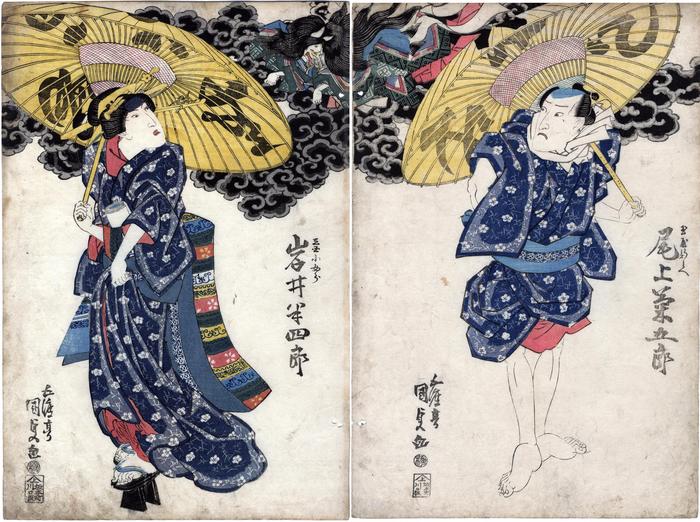Utagawa Kunisada (歌川国貞) / Toyokuni III (三代豊国) (artist 1786 – 01/12/1865)
Diptych: Tamamo no Mae with Iwai Hanshirō V (岩井半四郎) as Mikuniya Kojorō (三国屋小女郎) on the left and Onoe Kikugorō III (尾上菊五郎) as Tamaya Shimbei (三浦屋新兵へ) on the right in the play Shinjū to tare mo yūdachi (心中誰夕立)
05/1833
10 in x 15 in (Overall dimensions) color woodblock prints
Signed: Gototei Kunisada ga
五渡亭国貞画
Publisher: Kawaguchiya Uhei
(Marks 232 - seal 22-050)
Censor's seal: kiwame
Mead Art Museum, Amherst
Hankyu Culture Foundation - right panel
Hankyu Culture Foundation - left panel Sarah Thompson wrote of this theme: “The story of Tamaya, a young man from a wealthy merchant family in Echizen Province who ruined himself financially for the love of the Kyoto courtesan Kojorō, was already a subject of romantic ballads in the late seventeenth century. In the eighteenth century, it became the basis for books and plays as well.” Thompson even describes one version in which Tamaya was caught shorthanded in Kojorō’s brothel and therefore was punished by being put in a barrel with a small, cut-out window (an okebuse) facing the entry to the pleasure district.
Two actors under umbrellas look up fearfully at the apparition of the Cat Witch Okabe flying above them through a thunder-cloud. A fine dramatic composition.
The word 'yūdachi' (夕立) means 'sudden shower'. 'Shinjū' means 'double suicide'.
****
The name of the actor on the left is the same in each of the examples shown at the Mead Art Museum and the Hankyu Culture Foundation, but the name of the role at the later is different from the one in Amherst and in the Lyon Collection. The Hankyu character is Katsusaya Kojorō (かつさや小女郎). Clearly this would indicate different editions of this diptych.
Notice also the difference in the inking of the robes this example and those at the Hankyu Culture Foundation. This strengthens our argument for different editions. Which of the two is earlier is still up in the air. (JSV)
Yūrei-zu (幽霊図 - ghosts demons monsters and spirits) (genre)
actor prints (yakusha-e - 役者絵) (genre)
Kawaguchiya Uhei (川口屋卯兵衛) (publisher)
Iwai Hanshirō V (五代目岩井半四郎: 11/1804-11/1832) (actor)
Onoe Kikugorō III (三代目尾上菊五郎: 11/1815-3/1848) (actor)
